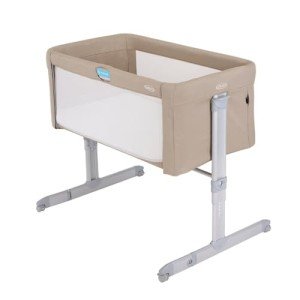Understanding Baby Co-Sleeper Cribs: A Comprehensive Guide
As new parents prepare for the arrival of their children, the argument over sleeping arrangements typically emerges. The option in between separate cribs, bed-sharing, and co-sleeping is a substantial factor to consider. In current years, co-sleeper cribs have acquired significant appeal due to their perceived benefits for both parents and infants. Bedside Cot That Attaches To Bed will explore what baby co-sleeper cribs are, their advantages and drawbacks, how they compare to traditional cribs, and vital security guidelines.
What is a Baby Co-Sleeper Crib?
A baby co-sleeper crib, likewise understood as a bedside crib or sidecar crib, is developed to be put beside the parent's bed. It enables parents to have their baby nearby during sleep without the risks connected with bed-sharing. These specially designed cribs often feature adjustable height settings, safety straps, and a removable side panel, making them a convenient choice for nighttime feeding and soothing.
Secret Features of Co-Sleeper Cribs:
- Height Adjustability: Enables the crib to line up completely with the parents' mattress.
- Detachable Side Panel: Facilitates easy access to the baby for feeding or soothing.
- Safety Straps: Secure the crib to the moms and dad's bed to avoid any gaps.
- Compact Design: Saves space while providing comfort.
Advantages of Co-Sleeper Cribs
Co-sleeper cribs provide many advantages for both parents and babies.
- Benefit of Nighttime Feeding: The close distance enables parents to more quickly breastfeed or bottle-feed during the night.
- Promotes Bonding: Parents can more quickly comfort their babies, creating a strong emotional bond.
- Enhanced Sleep: Many parents find that having the baby close at hand lowers nighttime stress and anxiety, leading to much better sleep for everyone.
- Much easier Monitoring: Parents can keep a close eye on their baby while sleeping, guaranteeing they are safe and comfortable.
- More secure Alternative: Co-sleeper cribs lower the dangers related to bed-sharing, such as suffocation events.
Table 1: Advantages of Co-Sleeper Cribs
| Benefit | Description |
|---|---|
| Convenience of Nighttime Feeding | Reduce of access for breastfeeding or calming babies at night. |
| Promotes Bonding | Improved emotional connection through proximity during sleep. |
| Enhanced Sleep | Decreased adult anxiety results in a more relaxing night. |
| Easier Monitoring | Localized view enhances reassurance for parents. |
| Much safer Alternative | Lower threat of suffocation compared to bed-sharing. |
Disadvantages of Co-Sleeper Cribs
While co-sleeper cribs come with a number of benefits, they also have some disadvantages.
- Limited Use: Co-sleeper cribs are typically just utilized for the first 6 months or two, till the baby starts to walk around.
- Expense: Quality co-sleeper cribs can be more costly than standard cribs.
- Space Constraints: A co-sleeper crib needs sufficient space beside the adult bed, which may not be offered in smaller sized spaces.
- Feasibility for Larger Adults: Some grownups might find it uncomfortable to lean over the crib for nighttime needs.
Table 2: Disadvantages of Co-Sleeper Cribs
| Drawback | Description |
|---|---|
| Minimal Use | Usable only for a brief time up until the baby grows. |
| Cost | Higher cost point compared to traditional options. |
| Space Constraints | Requires adequate space surrounding to the adult bed. |
| Feasibility for Larger Adults | May cause discomfort when reaching over for nighttime care. |
Comparing Co-Sleeper Cribs to Traditional Cribs
The choice between co-sleeper cribs and conventional cribs significantly affects the parenting experience.
Secret Differences:
| Feature | Co-Sleeper Crib | Traditional Crib |
|---|---|---|
| Distance | Beside moms and dad's bed | Separate room |
| Availability | Easy reach for nighttime care | Needs rising |
| Period of Use | 0-6 months, depending upon growth | Usually used for a number of years |
| Size | Compact and space-saving | Generally larger and more steady |
Safety Guidelines for Co-Sleeper Cribs
To make sure the safest sleeping plan, parents need to abide by particular security guidelines when utilizing a co-sleeper crib:
- Secure the Crib: Use security straps or attaching systems to protect the co-sleeper to the adult bed, reducing space in between the two.
- Use a Firm Mattress: Make sure the mattress is firm and fits comfortably within the crib.
- Prevent Soft Bedding: Minimize using soft objects such as pillows, blankets, or packed toys in the crib.
- Monitor Baby's Movement: Stay mindful to how the baby moves throughout sleep.
FAQs about Baby Co-Sleeper Cribs
Q1: Are co-sleeper cribs safe?
A1: Yes, when used according to safety standards, co-sleeper cribs can supply a safe sleep environment while keeping the baby close to the parents.
Q2: How long can I use a co-sleeper crib?
A2: Co-sleeper cribs are generally developed for use from birth till the baby is around 6 months old or can press themselves up.
Q3: Can I use a co-sleeper crib if I have a small bedroom?
A3: Yes, most co-sleeper cribs have a compact design, making them suitable for small spaces.
Q4: Do co-sleeper cribs require assembly?
A4: Most co-sleeper cribs require some assembly, however the process is usually straightforward and accompanied by instructions.
Q5: What should I do if my baby grows out of the co-sleeper?
A5: Transition your baby to a conventional crib in their own room or a neighboring place that follows safe sleep guidelines.
Baby co-sleeper cribs supply a compelling alternative for parents who wish to keep their infants nearby throughout sleep. They offer numerous benefits, consisting of ease of nighttime feeding and promoting close bonds. Nevertheless, like all parenting choices, it's necessary to weigh the advantages and drawbacks and think about private living scenarios and choices. By sticking to security standards, parents can produce a safe sleep environment for their little ones, guaranteeing assurance for the entire family.

